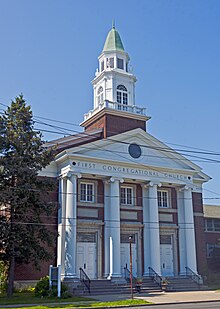| First Congregational Church of Albany | |
|---|---|
 East (front) elevation, 2015 | |
| Religion | |
| Affiliation | United Church of Christ, National Association of Congregational Christian Churches [1] |
| Leadership | The Rev. James Eaton[2] |
| Year consecrated | 1919 |
| Location | |
| Location | Albany, NY, US |
| Geographic coordinates | 42°39′15″N 73°47′10″W / 42.65404°N 73.78602°W |
| Architecture | |
| Architect(s) | Fuller & Robinson Company; Charles A. Schade[3] |
| Style | Wren–Gibss Colonial Revival, Modern[3] |
| Groundbreaking | 1917[3] |
| Completed | 1961[3] |
| Specifications | |
| Direction of façade | East |
| Spire(s) | 1 |
| Materials | Steel, stone, brick, asphalt |
| U.S. National Register of Historic Places | |
| Added to NRHP | February 14, 2014 |
| NRHP Reference no. | 14000259[4] |
| Website | |
| First Congregational Church of Albany | |
The First Congregational Church of Albany, also known as The Ray Palmer Memorial, is located on Quail Street in the Woodlawn section of Albany, New York, United States. It is a brick building in the Colonial Revival architectural style built in the 1910s and expanded half a century later. In 2014 it was listed on the National Register of Historic Places.[4]
Within two years of its establishment in 1850 the congregation hosted the Albany Convention, a gathering which helped Congregationalism develop a nationwide reach. The Rev. Ray Palmer, later known for his hymns, guided the church through its early years, when it was located in downtown Albany, first in a former Presbyterian church and later in its own building. In the early 20th century, the church followed its congregants in moving out towards the more suburban areas of Albany being developed along the city's trolley lines.
The Fuller & Robinson Company designed the present church, following the Wren–Gibbs tradition. It was the first Colonial Revival[3] church[a] in the city, attracting much local media attention.[6] Construction was delayed by the onset of World War I; it was formally dedicated to Ray Palmer in 1919.
As one of the first churches to establish itself in those areas, it formed a social center of the new neighborhood. After World War II, plans went ahead to build a Sunday school wing intended for the original church. It was completed, in an architecturally sympathetic modernist style, by the early 1960s. It continues to have an active congregation, affiliated with both the United Church of Christ and National Association of Congregational Christian Churches.[1]
- ^ a b "Foundations of First Congregational Church". First Congregational Church of Albany. Retrieved January 15, 2016.
- ^ "First Congregational Church of Albany". First Congregational Church of Albany. Archived from the original on January 12, 2016. Retrieved January 10, 2016.
- ^ a b c d e "Cultural Resource Information System (CRIS)". New York State Office of Parks, Recreation and Historic Preservation. Archived from the original (Searchable database) on 2015-07-01. Retrieved 2015-12-01. Note: This includes Jennifer Walkowski (March 2014). "National Register of Historic Places Registration Form: First Congregational Church of Albany" (PDF). Retrieved 2015-12-01. and Accompanying photographs
- ^ a b "National Register of Historic Places Listings". Weekly List of Actions Taken on Properties: 5/26/14 through 5/30/14. National Park Service. 2014-06-06.
- ^ Neil G. Larson (May 1981). "National Register of Historic Places Registration: Benjamin Walworth Arnold House and Carriage House". New York State Office of Parks, Recreation and Historic Preservation. Archived from the original on March 3, 2016. Retrieved January 30, 2016.
- ^ "Relocation to 405 Quail Street (1917)". First Congregational Church of Albany. Archived from the original on 2016-01-31. Retrieved January 14, 2016.
Cite error: There are <ref group=lower-alpha> tags or {{efn}} templates on this page, but the references will not show without a {{reflist|group=lower-alpha}} template or {{notelist}} template (see the help page).
